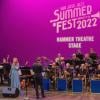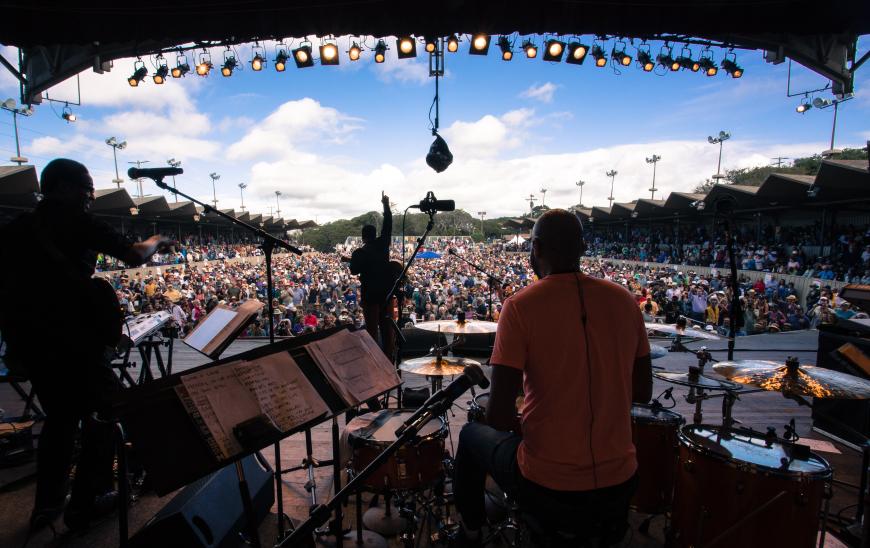
The Monterey Jazz Festival isn’t back to normal yet, and it turns out that normal can be overrated.
The 65th edition of the world’s longest-running jazz festival returned to the Monterey County Fairgrounds last weekend after a radically reduced production in 2021 that featured two outdoor stages while forgoing the three traditional indoor venues. Planning amid the vicissitudes of COVID’s evolution, the festival again presented this year’s program entirely al fresco, but with four stages running the length of the fairgrounds. Lucking out with a weekend of glorious Central Coast weather made roaming around the oak-shaded environs a pleasure unto itself.
The new configuration presented some logistical challenges, particularly long lines at the reduced number of food booths, but the music arrived in an overwhelming torrent, offering a deeply satisfying roster of artists representing many of the genre’s most interesting directions. The festival’s highlight arrived early with Friday’s mainstage performance of La Creación, a late-career masterwork by Cuban pianist and composer Chucho Valdés. Featuring his Yoruban Orchestra, directed by pianist Hilario Durán, and MONK’estra, directed by pianist John Beasley, the three-part suite is a densely orchestrated map that wends from West Africa to Cuba to New York City, a journey that Valdés guided with magisterial solo piano passages.
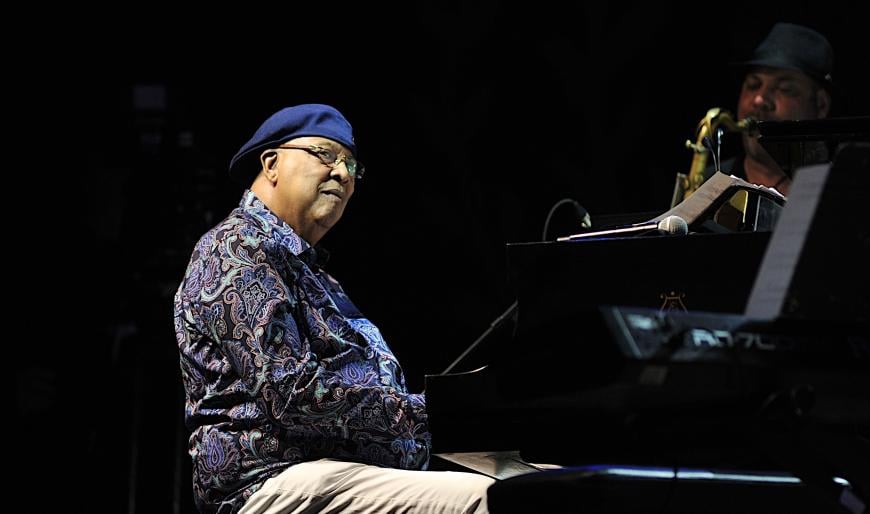
From the opening Yoruba invocation, La Creación evoked the unbroken cultural chain that Valdés has explored for much of his life. Gathering furious power, the music seemed to sweep across the arena, opening up as alto saxophonist Marcus Strickland slashed through the churning percussion. The trumpet section gave form to each geographical/historical shift, climaxing as Etienne Charles and Brian Lynch traded bristling high-note runs. On several passages Beasley took over the lead line on melodica, surfing the cresting orchestra and bata drum-driven polyrhythmic lattice. As the piece roared to a conclusion, it wasn’t so much celebratory as triumphant, a statement embodying the power of spiritual continuity.
If the diasporic connections linking Cuba to New York City drive the narrative arc of La Creación, Friday’s other highlight flowed from a very different musical exchange. Bay Area drummer Akira Tana founded Otonowa in response to the 2011 earthquake and tsunami that devastated northern Japan. Annual trips to the region and a series of excellent recordings transformed the project into a singular quartet with a repertoire drawn from a variety of Japanese musical sources, traditional and popular. Featuring abidingly lyrical bassist Ken Okada, pianist Art Hirahara, and Masaru Koga on tenor and soprano saxophones and a variety of flutes (including shakuhachi), Otonowa seemed to echo the endless possibilities of the bright blue afternoon sky.
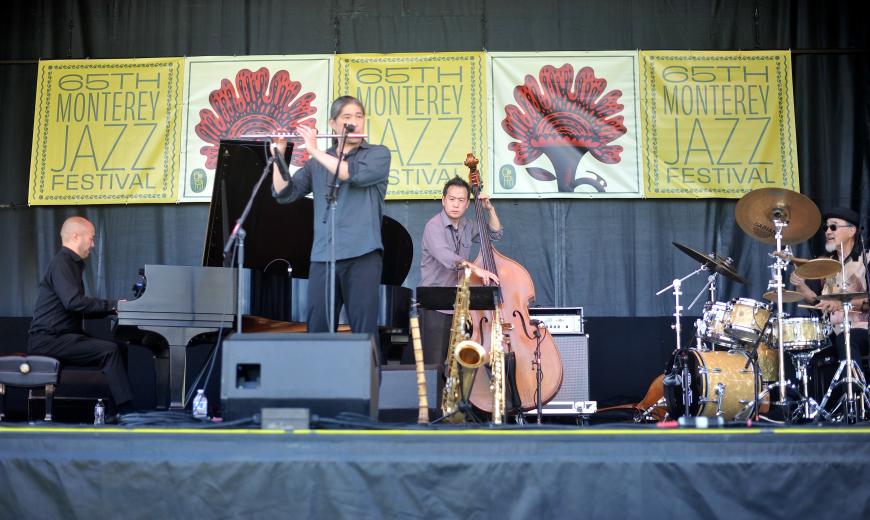
Playing on the West End Stage, the group turned confections like “Koi no Vacance” (a song made famous by the twin-sister act The Peanuts) into a soaring theme that, like many of the ensemble’s pieces, could have passed for an Irish air. Hirahara, a San José native who’s become a major contributor to the New York scene over the past two decades, sculpted sleek, arrestingly beautiful statements with each solo.
One welcome holdover from last year was the small, moat-surrounded Courtyard Stage, which took over the role of the indoor cafe venue that at past festivals often featured a single piano trio playing three sets over the course of a day. On Friday, drummer Jeremy Steinkoler’s mighty East Bay combo Mo’Fone, a trio with Jim Peterson on baritone saxophone and Larry De La Cruz on alto, held down the peninsular bandstand with potent, gutbucket grooves. The band has a particular affinity for New Orleans, but no tune better captures the trio’s ability to sound like a band twice its size than their relentlessly festive version of Joe Zawinul’s Weather Report classic, “Black Market.”
Saturday’s program demonstrated that the festival’s belated but intent focus on women players, an initiative launched in 2018, hasn’t been sidetracked by the pandemic. The first set of the day on the Garden Stage featured the Next Generation Women in Jazz Combo, an all-star high school sextet with trumpeter Skylar Tang, violinist Jacqueline Lee, pianist Kaiya Brooks, bassist Ruby Farmer, drummer Jillian Upshaw, and baritone saxophonist Noa Zebley (who’s already matriculated to Berklee).
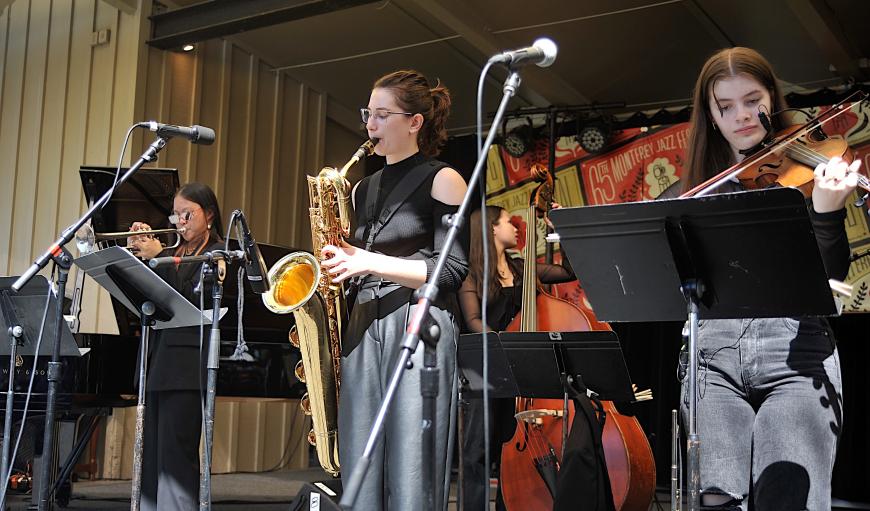
Directed by bassist Katie Thiroux, the group was created to encourage girls to audition for the festival’s Next Generation Jazz Orchestra program. It’s succeeded on that front, but the combo has also taken on a life of its own, turning into a showcase for some of the best young players around.
Alternating between original tunes and arrangements of jazz classics, the band opened with a swaggering version of Joe Zawinul’s rollicking blues “Scotch and Water” (arranged by Farmer). With Zebley moving to flute, the group’s palette dialed several degrees lighter on “Window Into Nothing,” a striking original by Tang. Beyond their command of their instruments, what stands out about the combo is the rhythmic drive produced by the Farmer/Upshaw tandem and the way the arrangements effectively deploy the unusual instrumentation. These are all players who are going places.
A little later in the day, Sal’s Greenhouse turned the sun-dappled Garden Stage into a sweaty nightclub with organ-driven funk. Led by vocalist/baritone saxophonist Sally Green, the Oakland combo brings the party, and her band delivers chunky grooves with efficiency and commitment. Running over to the West End Stage to catch New York vocalist/guitarist Fleurine’s charming set of bossa nova and Brazilian jazz meant a different kind of party. Backed by a stellar band of Brazilian-born musicians, the Dutch-born songwriter focused on originals, alternating between English and Portuguese lyrics that often centered, with humor and tenderness, on parenthood.
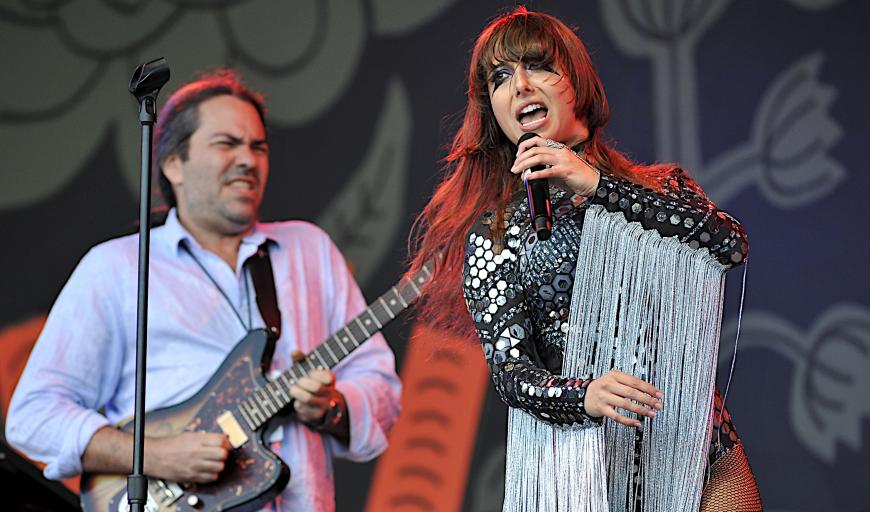
The extraordinary 28-year-old vocalist Veronica Swift delivered the festival’s most perplexing set, taking the arena stage with a seven-piece band whose members looked like they’d shown up for three different gigs. Swift and her drummer Brian Viglione seemed to have stepped out of a glam-rock band, circa 1973, while baritone saxophonist Lauren Sevian dressed for a formal event. The rest of the cats wore jazz casual. The sartorial muddle wouldn’t be notable if it didn’t echo Swift’s program.
A virtuosic jazz singer with the talent and intelligence to match her prodigious ambitions, she opened with a powerhouse take on “How Lovely to Be a Woman” that turned Ann Margret’s self-satisfied Bye Bye Birdie number into satire doing summersaults. Swift was at her most commanding on her original ballad “A Stranger in Town,” an anguished tune she sang with exquisite control and liquid phrasing. Her technique is nonpareil. But pivoting to a section of horn-driven jazz rock with the Blood, Sweat & Tears number “More and More” made the set feel like a pastiche. Her performance was impressive, but the transition between moods was too abrupt and bumpy as her rockstar moves competed with the material. She’s too good a singer to keep getting in the way of her music.
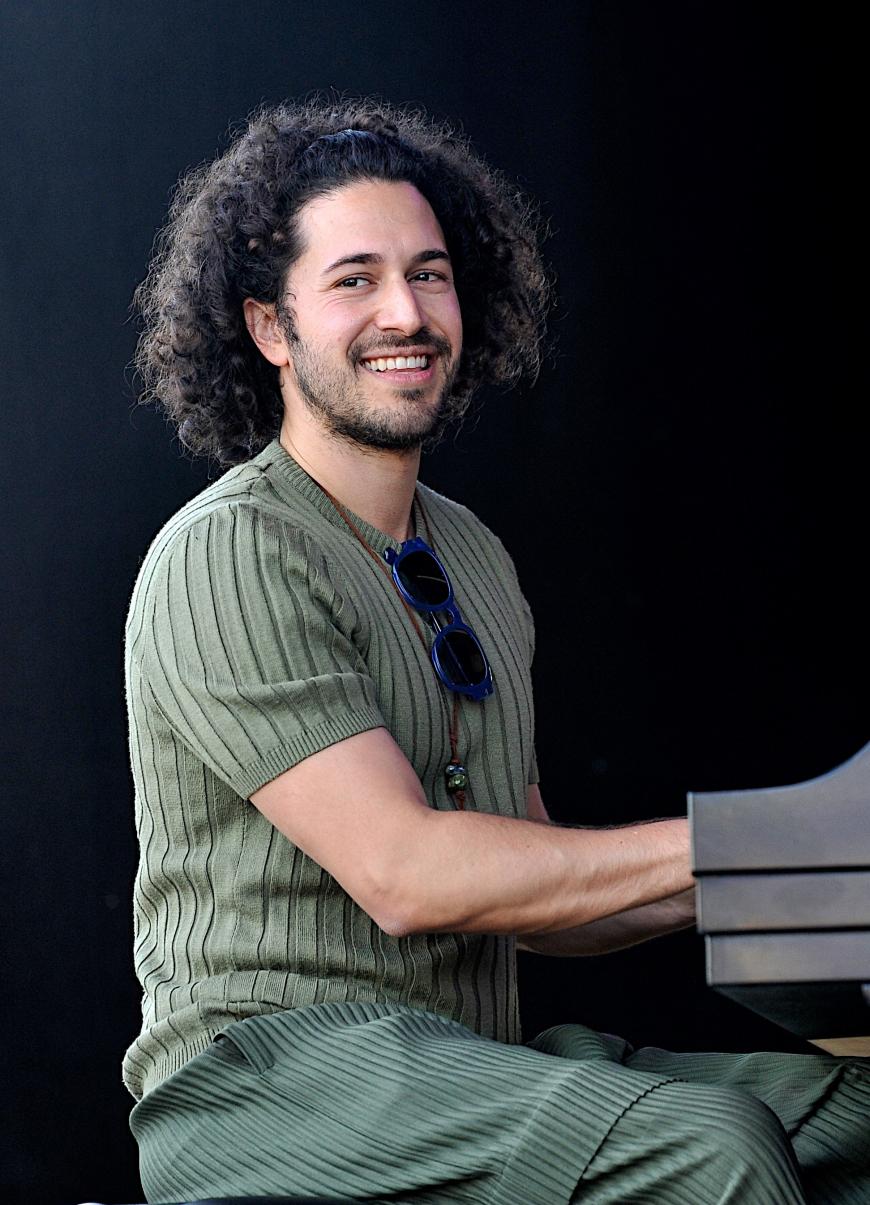
At the other side of the fairgrounds, Emmet Cohen turned the West End Stage into an intimate piano lounge with his highly responsive trio featuring bassist Philip Norris and drummer Evan Sherman. An effervescent player with a fierce left hand, Cohen spent much of the pandemic livestreaming from home, providing a welcome dose of swing through some of the darkest days of the pandemic. At his best he shapes material for maximum impact, like an arrangement of Neal Hefti’s “Shiny Stockings” that built slowly from a fingertip caress to an ecstatic full-bodied workout.
There was no drama on the Garden Stage with The Cookers, a band with enough talent to power a jazz festival by itself. Created by trumpeter David Weiss, who assembled the group as a vehicle for a swath of musicians who played a central role in defining jazz’s post-bop continuum in the 1960s and 70s, the septet plays original pieces, particularly by saxophone great Billy Harper, drummer Billy Hart, and bassist Cecil McBee. Pianist Stephen Scott, who’s been a bafflingly scarce presence on the West Coast in recent decades, covered the piano chair for George Cables. On Harper’s “The Call of the Wild and Peaceful Heart” and McBee’s own standard, “Peacemaker,” the 87-year-old bassist sounded as authoritative as in his Monterey debut in 1966 with saxophonist Charles Lloyd (a performance that yielded the million copy-selling album Forest Flower).
My evening came to a thrilling conclusion with Artemis, the all-women sextet led by pianist/composer Renee Rosnes (a founding member of the SFJAZZ Collective). With the band arrayed between the electrifying poles of Rosnes stage right and drummer Allison Miller stage left, the combo had a combustible group sound that snapped, bounced, and crackled, running through Noriko Ueda’s bass. Blending with precision, the front line of Ingrid Jensen’s bright, biting trumpet, Alexa Tarantino’s alto sax, and Nicole Glover’s tenor made the thematic statements as exciting as the solos.

Sunday’s most memorable sets opened and closed the day. The morning kicked off with a sanctified program led by pianist Tammy Hall, who’s been featured on the fairgrounds in many musical settings over the years. Turning the Garden Stage into a house of worship, Hall led a gospel program featuring members of the Texas Southern University and Morgan State University Choirs, with Patrick Sturgis on organ and lead vocals by Mark Brown and Nona Brown. Overflowing into the concourse, the audience soaked up the spirit, responding with raised arms, affirmations, and whoops of joy.
The last set of the night landed with the bracing stimulation of a smacked cheek. Nate Smith + KINFOLK is an electric band that taps into the compact energy of 1970s fusion but traffics in aggressive funk beats rather than rock. The band is a perfect marriage of Smith’s dazzling trap set control and pianist/keyboardist Jon Cowherd’s deep melodic well. Fima Ephron’s muscular and lyrical electric bass defined and elaborated on the rhythmic cycles, while guitarist Brad Allen Williams and alto saxophonist Jaleel Shaw, processing his sound to resemble a Stratocaster, moved through the episodic compositions with long, arching solos that furled through the shifting grooves. Joined by the beguiling vocalist Amma Whatt, KINFOLK closed the festival with the hippest set of the weekend.
Some final thoughts on the way that efficient booking can offer repeated and increasing rewards. After Hall’s gospel set, she returned to the Garden Stage in the evening to accompany Kim Nalley with special guest Houston Person, whose brusquely crooning tenor saxophone became Nalley’s fervent duet partner (turning “Try a Little Tenderness” into a gripping anthem). I didn’t catch enough of the late Saturday set by vibraphonist Joel Ross’s Good Vibes quintet with alto saxophonist Immanuel Wilkins, but what I heard left me hoping for the chance to see this configuration again. Gerald Clayton started Sunday directing the Next Generation in Jazz Orchestra in the arena, and a few hours later he returned to the West End Stage with a singular, spacious trio featuring Ross and Wilkins, an ensemble with a lean but sumptuously melodic sound laden with promise. That’s Monterey. There’s too much and not enough time to take it all in.


